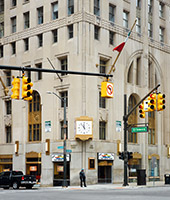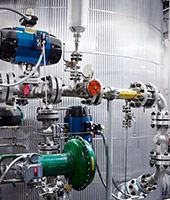WACKER Stock in 2015
WACKER’s share price was impacted not only by the IPO of Siltronic in June 2015, but also by developments in the solar and semiconductor industries. In addition, macroeconomic factors dampened the share price, including China’s uncertain growth trend and the strong drop in oil prices. Although the continued strength of the chemical divisions supported WACKER stock, by year end it was outweighed by doubts about future trends in the semiconductor market and the low price-level in our polysilicon business.
The stock was bolstered in Q1 2015 by eurozone and US central-bank policies, which extended bond-buying programs and combated deflationary tendencies with interest-rate cuts. The ongoing crises in Ukraine and the Middle East did not have any major impact. Overall, stock prices climb markedly in the quarter to March 2015, with the DAX posting its biggest quarterly gain since 2003. In this three-month period, the DAX rose by nearly 23 percent and the MDAX by 22 percent.
Given this favorable environment, WACKER stock climbed almost 19 percent from January through March, performing largely in line with the two main German benchmark indices. WACKER stock started Q1 2015 trading at € 90.85 on January 2. The price then edged down temporarily until mid-January, to its first-quarter low of € 83.53 on January 14. On March 10, 2015, WACKER announced that it would reorganize the ownership structure of Siltronic. The option of splitting off the capital-intensive and cyclical business of Siltronic inspired the imagination of investors. As a result, the stock reached its year-high of € 115.10 on March 11.
Closing at € 107.75 on March 31, the stock gained 18.6 percent in the first quarter, which corresponds to a market capitalization of € 5.35 billion.
The second quarter of 2015 was turbulent for international financial markets. As Q2 progressed, stock markets were increasingly affected by worries about the financial situation in Greece and, from mid-June, by concerns about the Chinese economy.
Initially, WACKER stock held its level of € 110. From mid-May, declining prices and new capacities for polysilicon clouded the outlook for the stock. Even the May 15 announcement about the IPO of Siltronic did not reverse this trend.
Siltronic made its debut on the Frankfurt Stock Exchange on June 11, with its issue price set at € 30.00 per share. Siltronic stock started trading in the regulated market segment (Prime Standard), under the ticker symbol WAF300 and the ISIN DE000WAF3001. A total of 12.65 million shares were placed, including the greenshoe option that the syndicate banks exercised in full on June 15. The total placement consisted of 5 million new shares issued through a capital increase at Siltronic and 7.65 million shares originally held by WACKER. The WACKER Group and Siltronic, together with the joint global coordinators and the joint bookrunners, had set the issue price at € 30 per share. The total proceeds from the IPO amounted to nearly € 380 million. The free float for Siltronic AG stands at 42.2 percent, with WACKER currently holding 57.8 percent of the shares.
Overall, WACKER stock decreased almost 15 percent in Q2. During the same period, the DAX lost close to 9 percent and the MDAX nearly 6 percent. WACKER stock started the second quarter trading at € 108.50 on April 1. Until mid-April, it resumed the upward trend of Q1, reaching its second-quarter high of € 114.75 on April 10. In the weeks that followed, the stock trended sideways. As market sentiment became increasingly negative, WACKER stock started losing ground from mid-May, as did the DAX and MDAX. On June 30, 2015, the stock posted its low for the quarter of € 92.60.
In Q3 2015, turbulence on financial markets in China dragged down equity markets. Investors were worried that a slowdown of China’s economy would cause a global economic slump. In particular, the stocks of major exporting companies fell. WACKER was not immune to this trend, given the large proportion of its products exported to Asia. Then came the news of the VW Group’s diesel-engine emissions tampering, which weighed on the stocks of auto makers and suppliers. As a result, Germany’s main equity benchmark, the DAX, fell below the psychologically important mark of 10,000 points for the second time within a very short period.
Given the difficult environment, news of further declines in polysilicon prices put WACKER stock under additional strain, even though the company’s production output remained good. Softer demand for smartphones and reduced inventories meant that plant utilization in the semiconductor sector dropped, dampening the expectations of silicon-wafer manufacturers. Overall, WACKER stock dropped 28 percent from the beginning of July to the end of September. In the same period, the DAX lost 14 percent and the MDAX 4 percent. WACKER stock had started Q3 2015 at € 93.92. It then dropped gradually and, on September 28, reached its third-quarter low of € 65.79. It closed the quarter at € 67.91.
In the fourth quarter, conditions on capital markets remained difficult. Oil prices (Brent) dropped by over 20 percent, from US$ 48 to US$ 37.6, in the final quarter. This reinforced investor hopes of positive effects for the global economy, despite the slowdown in China. As a result, the DAX climbed by nearly 13 percent in Q4 and the MDAX by 8.3 percent. On December 21, Siltronic’s stock was listed on the TecDAX.
From early October to year-end, WACKER stock gained 13.2 percent, advancing from € 68.50 to € 77.52.
During the year, discussions with capital-market participants were dominated by questions about supply/demand balance with regard to polysilicon and Siltronic. It was not until the Q3 report was released that the success of the chemical divisions moved more prominently into the foreground.




